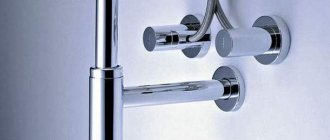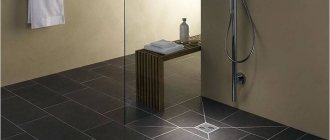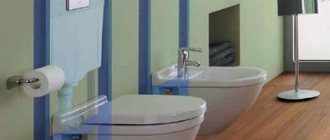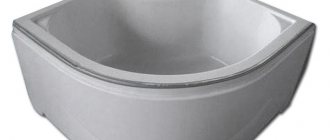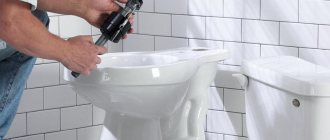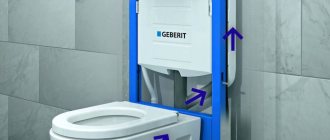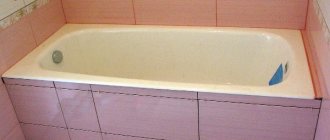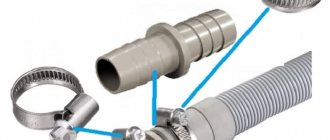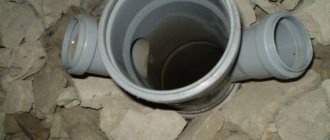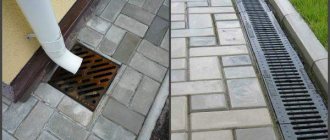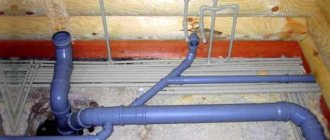Now everyone is trying to create their own bathroom design with the original shape and finish of the shower stall. This can be done with your own hands, but for effective operation you need the correct sewer drainage equipment. Here you will need a plumbing drain.
They perform the functions of draining liquids, filtering large polluting particles, and resisting the appearance of bad odors.
Purpose and design of drainage equipment
Sewage drains are installed at food or chemical industry enterprises, in public baths, swimming pools and laundries. Installing a shower room using such systems is cheaper than installing cabins with a tray.
The plumbing drain consists of the following elements:
- Water intake tray. The part is designed to collect and remove wastewater. The fastening element of the tray helps to securely fix the waterproofing layer of the floor.
- Siphon with protective grille. Prevents large particles of debris and dirt from entering the sewer system. The water seal retains gases that cause unpleasant odors in the room. The drains are equipped with mechanical or dry siphons.
- Branch with coupling. Located at the bottom of the body. The outlet connects the drainage system to the sewer pipe.
- Auxiliary elements. Sealing agents increase the tightness of plumbing fixtures. When purchasing a ladder, you need to assemble the product and check for gaps. Additionally, connecting nuts and pipes of the required size are prepared.
What it is?
The first logical association with the word gangway is, of course, fast airplanes and the snow-white lines of handsome motor ships. One of the components of the sewer drain has the same name. Without this part it is impossible to ensure normal drainage care. Then no amount of visual beauty of the bathroom, the furniture and plumbing installed in it will please you.
The main functions of this plumbing unit are related to:
- fluid drainage;
- filtration of large contaminants;
- blockade of bad odor.
Any drain for drainage, both domestic and industrial, may vary in:
- type of installation;
- own geometric shape;
- hole diameter;
- the material used;
- type of the main operating device (shutter).
All these subtleties should be taken into account immediately when purchasing. At the time of installation itself, it will no longer be possible to correct the error. Moreover, dismantling is much more difficult than the initial installation. You will have to completely disassemble the covering and remove the screed. Typically, shower cabins are equipped with drains of medium size and high power.
Types of materials for equipment production
On the left is a vertical, on the right is a horizontal sewer drain.
Depending on the material of manufacture, ladders are divided into the following types:
- Cast iron. They have high throughput. Difficulties may arise when installing equipment. Shower stalls in public institutions are equipped with cast iron products.
- Plastic. Insensitive to aggressive substances. Positive qualities include affordable price, light weight and long service life. Polymer drains are used in the construction of sewer systems in apartments and private houses.
- Steel. Stainless steel meets high sanitary requirements. Steel ladders are installed in kindergartens, hospitals, and canteens. The metal housing is easy to install. It is easy to clean from dirt.
Recommendations for selection
When choosing a dry sewer drain, it is recommended to pay attention to the following points:
- Decide on the number of risers. For a private house or apartment, you should choose a valve with a nominal bore (DN) of 50 mm.
- The product, which has a horizontal outlet, can be installed in confined spaces. Its height varies in the range of 6-10 cm. Models with a vertical outlet require 15-18 cm. Before installation, it is worth taking measurements and finding out which valve is suitable for a shower in a particular case.
- Before purchasing a sewer drain, it is recommended to check the serviceability of all its components and the functionality of the device (by pouring water from a bottle).
- Specify the size of the product based on the volume of waste. For a shower stall, it is enough to purchase a drain with average parameters and good throughput.
After finding out the technical characteristics of the drain, you can pay attention to its appearance.
Design Features
Based on the structure, the following types of drainage equipment are distinguished:
- Horizontal. Wastewater in such systems is discharged to the side. The ladder is easy to install with your own hands. The diameter of the sleeve must correspond to the size of the sewer pipe.
- Vertical. The body, which is a high ring, is capable of discharging a large volume of wastewater. It is recommended to choose products with a diameter of more than 100 mm. The top of the drain should not be located above floor level.
The throughput of the ladder varies. When installed in an apartment, this parameter should be at least 1.2 l/second. The protective grille has a round, square or rectangular shape. Using the last 2 types makes it easier to lay tiles.
Rating of shower drains
Professionals advise choosing a shower drain based on the required characteristics and reviews of owners of ready-made systems. The most recommended models on the market:
- AlcaPlast APV3444
is a point model with height adjustment and a dry and wet shutter system. Price – $36. - TECElinus 15101090 90
– wall-mounted model with installation below floor level. Features a stylish design. Price: $358. - Pestan Confluo Premium Line 650
is a linear shower drain with a dirt trap and a wet shutter. Price: $179. - Advantix Vario 704360
is another high-quality linear variety with a self-shortening siphon design. Price – $283.
Installation of a drain system
When installing a sewer drain, a change in floor height is required. The rapid outflow of water is facilitated by arranging a slope of 15 cm.
The work order includes the following stages:
- Laying a thermal insulation layer. Expanded polystyrene sheets 4-5 cm thick are suitable for this purpose.
- Arrangement of rough screed. Pour a layer of concrete 5 cm thick.
- Formation of a waterproofing layer.
- Creating a slope. This is done by pouring concrete mixture.
- Facing. The tiles are laid on a special solution.
It is optimal if the installation of a sewer drain is carried out at the stage of major repairs.
Preparing for work
Before installation, calculate the thickness of all floor levels. The lowest point of slope is determined taking into account the size of the ladder. The difference should be at least 1 cm per 1 m. If you choose a smaller slope, the water will stagnate in the shower stall. The distance from the protective grille to the wall should be equal to the size of the facing tile. This eliminates the need for cutting material.
Thermal insulation and rough screed
Laying of thermal insulation material occurs only after installing and fixing the ladder to the floor.
The procedure for insulating a bathroom floor when installing a drain includes the following steps:
- Connecting the drain to the sewer system. At this stage, it is important to correctly create the slope of the pipe. The joints are treated with sealant.
- Installation of thermal insulation boards. The insulator prevents deformation of the concrete screed due to temperature changes.
- Pouring cement screed. The thickness of the layer depends on the height of the ladder. The solution is evenly distributed near the outer surfaces of the drain. Align the screed at the level of the ladder fastening. The result should be a durable surface that can support the weight of several people.
Floor waterproofing
The best option is to use isoplast material reinforced with fiberglass. It is resistant to mechanical damage and temperature changes. The canvases are overlapped. A torch is used to soften the joints. The edges of the sheets are brought under the flange.
When laying waterproofing near the walls, an overlap is made to the level of the second layer of the floor. The edges are heated and glued to the surface. After the waterproof membrane has hardened, the siphon is inserted into the drain body. The connection is sealed with a ring.
Finishing screed and finishing
The final stage of installation includes the following steps:
- Installation of guides. Parts can be made from wooden blocks. After the screeds have hardened, they are removed. PVC guides are also used, which, after the concrete solution dries, turn into expansion joints. The bars are laid at an angle corresponding to the slope of the floor. Near the siphon, the width of the guides is reduced. The joints are sealed with sealing tape.
- Pouring concrete. The mixture is poured into a layer 3 cm thick and left for 2-3 days.
- Laying tiles. The facing material should not absorb moisture. The recommended water absorption rate is 1.5% of the tile weight. The tiles are laid on a waterproof adhesive. The gaps between the tiles are closed with grout.
The installation work is completed by installing the drain grate.
Why do you need a shower drain?
The main functions performed by the drain can be described as follows:
- The most obvious is the collection and disposal of dirty water so that it does not spread over the entire floor area in the bathroom. That is, the device can still save the house from flooding, being an emergency source of drainage if the tap suddenly breaks or the owner forgets to turn off the water.
- Another important function is to trap any debris so that it does not fall into the drain hole. This is possible thanks to the removable filter grid.
- Another important nuance is that such a sewer system prevents sewer odors from entering and spreading in the room thanks to special water- or dry-type seals.
- The shower drain is an open system that provides access to the drain holes for clearing blockages.
